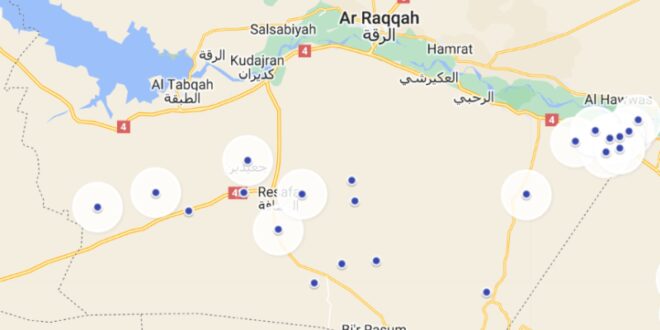ISIS carried out at least 69 confirmed attacks in March in the Aleppo, Homs, Hama, Raqqa, and Deir Ez Zor governorates. These attacks killed at least 84 pro-Assad regime soldiers and 44 civilians and wounded at least 51 more soldiers and civilians. There were also 19 high quality* attacks during the month. March was, by every metric, the most violent month of ISIS’s Badia insurgency since late 2017, when the group first lost control of its territory in central Syria. The number of attacks conducted in March exceeded the previous high point in January 2021, when ISIS cells were battling against significant regime operations across much of the desert. This month’s activities also far outpaced those of last year’s truffle season, when ISIS cells killed at least 115 people in April. However, most of the attacks that month —as well as the two preceding high-intensity months—were against civilians.
The unique and alarming difference in March was the scale of attacks against security forces. Across Homs, Hama, and Deir Ez Zor, ISIS cells successfully and consistently targeted regime outposts and ambushed patrols, frequently capturing and executing soldiers. The group also continues to expand its urban operations in Deir Ez Zor, where multiple attacks were conducted against local religious officials and intelligence members inside Mayadin. Civilians also came under increased threat as the truffle season reached its zenith. Groups of armed and unarmed civilians were ambushed, kidnapped, and executed across Raqqa, Deir Ez Zor, and Hama, and others fell prey to mines.
However, less than one-third of all documented attacks in March involved mines or improvised explosive devices (IEDs). Most attacks against both security forces and civilians were from ISIS militants actively engaging with and ambushing their victims. This more aggressive and confident posture has been evident since the fall of 2023, and so far, shows no signs of abating. As in recent months, March also saw the continuation of confirmed ISIS losses both from Russian airstrikes and battles with regime forces. Journalist Zain al-Abidin documented at least eight ISIS fighters killed across central Syria in March, compared with 18 killed in February and 20 killed and captured in January.
Violent activity continues to be concentrated in Homs province, where the group has been conducting a high tempo of offensive activity against regime positions since October 2023. As in February, March was marked by consistent ISIS attacks against regime positions in the Jubb Jarah area north of Palmyra. ISIS cells also greatly expanded operations in eastern Hama, particularly along the Hama side of Jubb Jarah and the Bala’as mountains, effectively creating one long front of continued attacks from southeast Hama into northeast Homs. In Deir Ez Zor and Raqqa, ISIS cells continued to expand their operations inside urban areas, particularly in Mayadin and in the Ma’adan area, respectively.
ISIS began to claim Badia attacks consistently for the first time since 2022, during their global “And Kill Them Where You Find Them” campaign in January 2024. This higher rate of claims has continued into March, when the group claimed 12 attacks in central Syria (twice what they claimed in February).
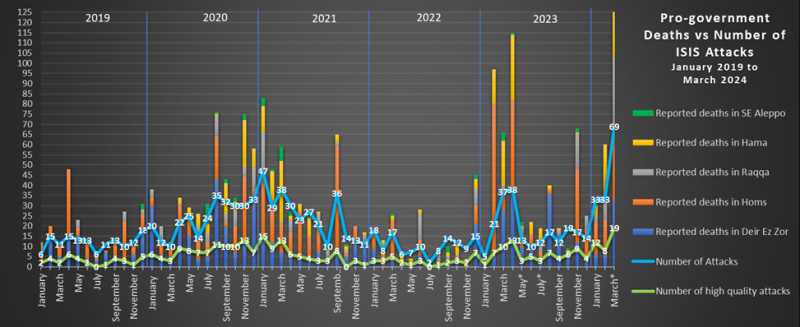
Confirmed ISIS attacks increased in every governorate, more than doubling in Deir Ez Zor (17) and Raqqa (14). Hom (25) reached a record number of attacks while Hama (12) saw more attacks in March than in any month over the past three years. Only Aleppo (1) followed the normal trends in activity.
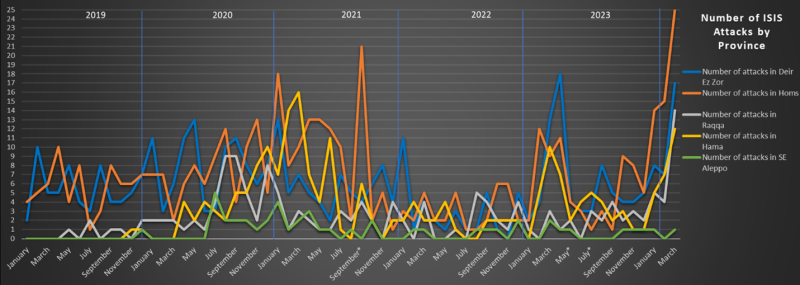
Deir Ez Zor and Raqqa
ISIS expanded its low-level insurgency within the urban belt of Deir Ez Zor in January, when it conducted three assassinations of local security members. Sleeper cells continued this trend in February, carrying out two assassinations of local pro-regime fighters inside Mayadin city, and again in March when unidentified gunmen conducted three attacks inside Mayadin and one attack on the edge of Shamitiyah. However, the bulk of attacks this month occurred around the traditional ISIS stronghold of Jabal Bishri.
On March 2, two truffle hunters were killed by a mine in the desert outside Masrib, west Deir Ez Zor. On March 5, suspected ISIS militants conducted two attacks against regime positions in west Deir Ez Zor. One targeted the army’s 4th Division position at the Shamitiyah water tower, killing at least two, including a colonel. The second hit an outpost outside Shoula, killing at least two 17th Division soldiers (local opposition media claimed there were four dead in each of the two attacks, but loyalist media only announced the names of two soldiers in each).
On March 9, six locals were killed when their truck hit a mine in the Harbisha area along the Homs-Deir Ez Zor border, just north of the highway. On March 12, at least one soldier was killed when his position was attacked in the Dweir desert. The next day, gunmen attacked a group of truffle pickers in the Bishri desert, leaving two dead and one wounded. One of the killed men was a member of the local pro-regime National Defense Forces (NDF). On March 15, another solider was shot to death in Dweir, this time closer to the city itself. On March 16, a member of the 4th Division’s 42nd Brigade was killed when his truck hit a mine in the Jabal Bishri area. That same day, suspected ISIS militants assassinated the head of religious endowments in Mayadin, Talal Al-Khater, as he left a mosque. On March 17, ISIS fighters attacked another group of truffle hunters and their NDF escorts, this time in the Masrib area.
On March 20, at least two NDF fighters were killed and one injured when their motorcycle hit a mine in the Bishri desert area. That same day, three soldiers were killed when their position was attacked in the Shamitiyah desert. The next day, two gunmen attacked a State Security patrol inside Mayadin. Both assailants were detained following a shootout. On March 23, another NDF fighter, Aboud al-Zamal, was killed by a mine as he searched for truffles in the Bishri desert. According to Zain al-Abidin, al-Zamal had been a refugee living in Turkey until 2023, when he was deported by local authorities. Following his return to his home in western Deir Ez Zor, he joined the local NDF.
On March 25, unknown gunmen targeted another State Security patrol inside Mayadin, the third attack of the month inside the city. On March 26, loyalist media reported the disappearance of seven soldiers near Kabajib as they traveled along the Sukhnah-Deir Ez Zor road. On March 29, two more soldiers were reported killed in clashes near the village. Another soldier was reported killed in Deir Ez Zor by his hometown on March 31, however it is likely that he was part of the March 26 group.
In Raqqa, ISIS’s low-level but significant insurgency escalated in March. Security forces recaptured the Zamleh hamlet, reopening the Kawm-Resafa highway, but ISIS cells stepped up attacks in and around the town of Maadan and in the area west of Resafa. Raqqa saw the greatest number of civilian deaths in March, with 26 slain and most attacks targeting truffle hunters.
On March 1, three truffle hunters were killed by a mine near Maadan. On March 2, ISIS gunmen assassinated a 17th Division soldier as he drove home in Maadan. The group later claimed the attack and published a picture of the moment the militants opened fire. This is the first attack of its kind in regime-held Raqqa and directly mirrors the type of assassinations ISIS cells regularly conduct against Syrian Democratic Forces (SDF) fighters north of the Euphrates River.
On March 11, a 4th Division soldier was injured by a landmine south of Resafa, according to Zain al-Abidin. The next day, at least one local NDF fighter disappeared while searching for truffles near the village of Sweida. His body was found with a gunshot to the head on March 13. On March 15, one local was wounded by a mine while truffle hunting in the Mansoura desert, south of Tabqa and west of Resafa. The next day a truck carrying a group of truffle hunters hit a mine in the Sabkha desert, killing 12 and wounding 10. On March 18, two mines hit civilians in the Maadan area, leaving one dead and two injured in total. As Zain al-Abidin rightly notes, this area has never seen mine incidents before, suggesting that these are newly laid by the same ISIS cells who conducted the March 2 assassination in Maadan.
On March 21, a group of seven truffle hunters and their four local NDF escorts disappear in the Maadan countryside. All bodies were found over the ensuing days. One member of the search party drove over a mine on March 23, resulting in injuries. On March 25, a pro-regime militia fighter was wounded by a mine west of Resafa. On March 28, five locals were wounded by a mine while truffle hunting along the Tabqa-Ithriyah road. On March 29, two locals were killed by a mine on a road outside Maadan.
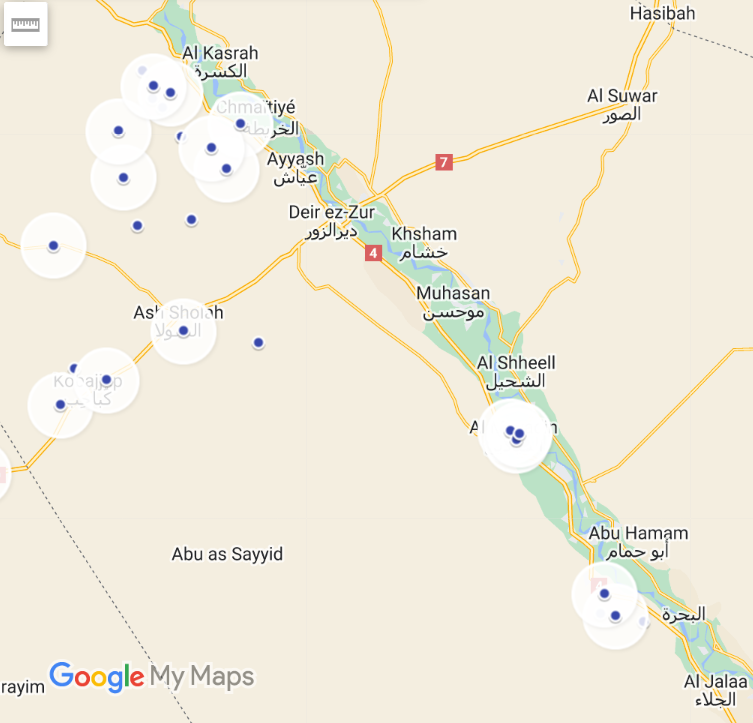
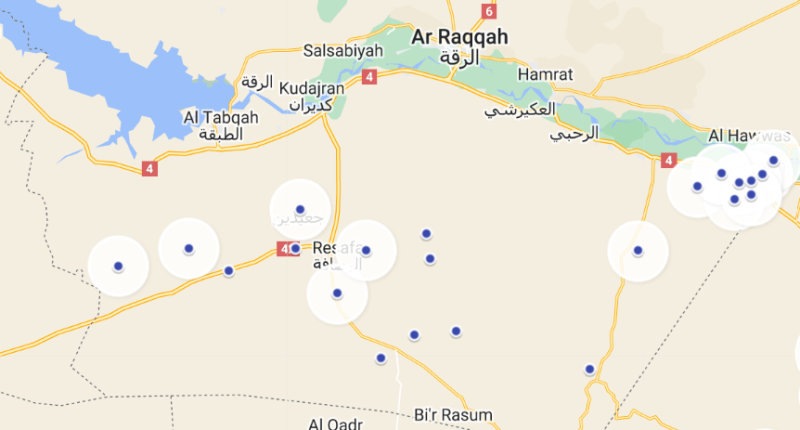
Homs
ISIS activity in eastern Homs decreased in December, but remained focused around the Doubayat Oil Field, which the group had temporarily captured in November. January likewise saw most ISIS activity concentrated in this area, though the group also expanded operations west into the desert just south of Palmyra and Arak. In February, ISIS largely abandoned the southern Palmyra front, likely because of pro-regime ground and air operations, and shifted its focus to the Taybeh sector north of Sukhnah and the Jubb Jarah mountains north of Palmyra. This focus continued into March, with the bulk of attacks occurring in Jubb Jarah and around Sukhnah. ISIS cells had much more success in the former, while security forces continue to stand their ground in the latter.
On March 1, ISIS claimed two attacks in the east Sukhnah countryside. The group claimed to have infiltrated a regime position and detonated an IED under a tank, publishing a picture of an explosion, also claiming a small arms attack against a separate barracks. On March 2, two shepherds were executed in the northeast Jubb Jarah area. That same day, two members of the pro-regime al-Assad Shield Forces were wounded during an attack on their position in Jubb Jarah. The militia established new outposts in this area at the beginning of 2024, which have since been a regular target of ISIS attacks.
On March 6, a civilian convoy was attacked in the Wadi Didi area along the Homs-Deir Ez Zor border, north of the highway, leaving three dead, seven wounded, and 12 cars burned. Attackers could be seen in pictures driving away in two trucks. On March 7, ISIS claimed it captured and executed three soldiers in the Sukhnah countryside, releasing a picture of one of the executed men. That same day, two civilians disappeared while truffle hunting around the Abyad Dam, north of Palmyra. On March 12, four members of the Iran-backed Local Defense Forces were captured and executed near the Tuwaynan field, north of Sukhnah. ISIS later released pictures of the men claiming they were captured while truffle hunting outside of their outpost. Also that day, ISIS militants launched an attack on Taybeh, wounding three Iran-backed Afghan foreign fighters.
On March 14, loyalist media reported the disappearance of three soldiers from the eastern Wadi Doubayat axis. On March 17, ISIS militants launched attacks against regime forces near Qulay, northeast of Sukhnah, followed by attacks on the nearby al-Hayr al-Sharqi hamlet on March 18. Elsewhere on March 18, three soldiers were killed and three injured when their position was attacked near the Abyad dam, while ISIS militants continued to attack positions east of the Doubayat field. These last attacks ultimately failed due to the intervention of Russian jets, which killed at least four ISIS members.
On March 19, two local NDF members went missing while truffle hunting outside their position in Jubb Jarah. Their bodies were found several days later. Also on March 19, a soldier was killed and two wounded in an attack near Tuwaynan. On March 20, a soldier was killed in an attack near Sukhnah. On March 22, ISIS cells launched attacks against regime positions east of Taybeh and on the southern axis of Doubayat Gas Field, according to Zain al-Abidin. On March 23, a member of the regime’s 25th Division was killed by a mine while driving in the Jubb Jarah region.
On March 24, ISIS militants kidnapped several shepherds and killed dozens of sheep in an attack in Jubb Jarah. That same day, the group claimed to have captured and executed two soldiers in the Palmyra countryside. The next day, the group again claimed to have captured and executed four soldiers, this time west of Sukhnah. On March 27, two soldiers were reported missing in action while traveling outside Sukhnah. ISIS later published pictures showing them captured and executed. On March 28, five soldiers were killed and two wounded near the Abyad Dam when their position was attacked.
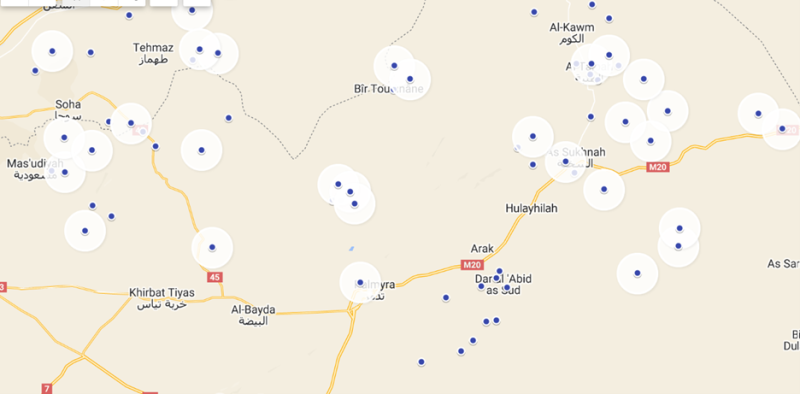
Hama and Aleppo
Significant ISIS activity returned to east Hama in January, when the group conducted five attacks in the province, three of which were deemed high quality. Likewise, ISIS conducted three high quality attacks in eastern Hama in February. This is the first time eastern Hama has had back-to-back months of three or more high quality attacks since spring of 2021, amid the regime’s semi-successful campaign to suppress ISIS activity in the province. In hindsight, it is clear this sustained escalation presaged the surge in activity seen in March, when ISIS cells conducted no less than 12 attacks, of which five can be deemed high quality. Unlike Raqqa, which saw a similar number of attacks, most of the Hama activity focused on security forces.
On March 6, a militia fighter was wounded by a mine near Ithriyah. The next day, seven members of the al-Assad Shield Forces were killed when their position near Tel Salama was attacked. ISIS quickly claimed credit for the assault and published pictures of the dead. On March 11, ISIS claimed to kill three more militia fighters in the eastern countryside while they were searching for truffles. On March 13, a shepherd was wounded by a mine in the Hamra subdistrict, north of Salamiyah. That day, four more militia fighters were reported killed when their position came under attack southwest of Duwazin, in the Jubb Jarah area of Hama. ISIS later claimed the attack, saying they had captured and executed one of the fighters. On March 15, a civilian car hit a mine near Wadi Azeeb, killing two and wounding one.
On March 16, local Facebook pages reported the disappearance of a member of a Military Intelligence militia while traveling on the road towards the Bala’as mountains from Uqayribat. On March 30, ISIS released pictures of four soldiers they had captured and executed, claiming the attack occurred “west of Palmyra”. However, one of the men clearly matched the soldier reported missing on March 16. Therefore, it appears a group of four soldiers in total were captured that day and later executed.
On March 19, a regime fighter was wounded by a mine on the Ithriyah-Tabqa road. He later died of his wounds. On March 24, regime forces clashed with ISIS militants east of Ithriyah. On March 27, four shepherds were kidnapped and hundreds of sheep were killed on the same Ithriyah road. On March 29, a local was shot and wounded while truffle hunting south of Ithriyah. On March 31, one soldier was killed and one wounded in clashes near Tel Salama.
On March 27, two NDF fighters were killed by a mine in Kulah al-Bawaidar, in the Khanasir desert of southern Aleppo.
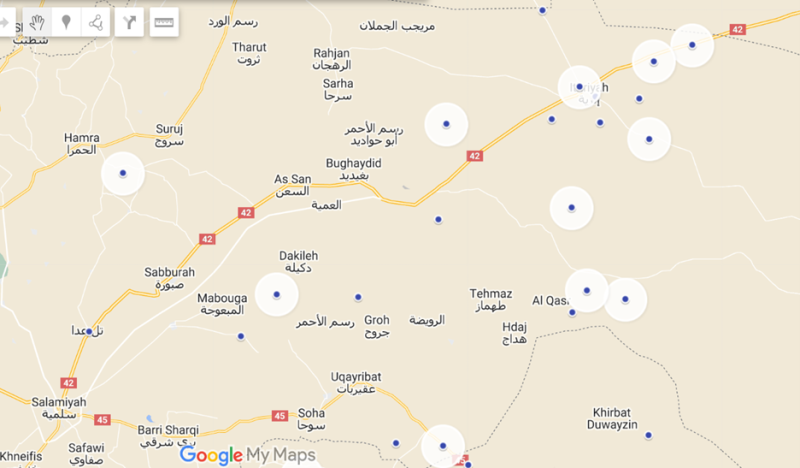
Looking Ahead
While March saw an unprecedented level of activity, it is not an isolated case. January and February likewise saw an extraordinary degree of attacks specifically targeting security forces (compared to this time last year when the surge in attacks was driven by violence against civilians). It is deeply concerning that ISIS cells have been able to maintain and even increase this degree of activity nearly unabated since October 2023, despite multiple regime operations that either stunted or pushed back ISIS’s offensives over the past six months. It cannot be denied at this point that ISIS has successfully replenished at least some of its manpower and equipment over the past two years.
The apparently bolstered Badia network has deployed these new resources in a much more aggressive manner than in past years. Since fall 2023, ISIS attacks have utilized more small arms than mines or IEDs. In other words, ISIS has for many months now shifted away from the more passive and defensive approach it largely adopted from late 2021 through early 2023. This more confident posture resulted in distinct and sustained offensive action at the end of 2023, when ISIS cells seized several strategic areas from regime forces. However, as expected ISIS eventually withdrew in the face of regime and allied operations.
It is important to set clear bounds on this unprecedented escalation in central Syria. ISIS is not poised to capture major cities like Sukhnah or Palmyra, and likely will be unable to capture smaller strategic objectives like Taybeh or al-Kawm (as long as Russian and Syrian jets continue to operate over the area). However, March’s attacks appear to show a pattern in which ISIS cells have seized control over much of the “empty” space outside hardened regime positions. At the very least these areas have been turned into no-man’s-land for the time being. Many attacks this month occurred when soldiers left their posts to look for truffles, while others successfully hit the positions themselves. This suggests that ISIS cells enjoy substantial freedom of movement between regime positions. This would limit the regime’s ability to conduct widespread, synchronized sweeping operations that might push cells out of key areas.
At this point it is unclear how long ISIS will sustain this level of activity. As long as the group continues to conduct these smaller raids, rather than large operations seeking to capture key areas, cells will likely continue to find success. However, as the truffle season comes to a close over April and May, the overall number of attacks may also decrease simply because there are fewer targets available. It remains to be seen if and how the regime can meaningfully change the current dynamics on the ground.
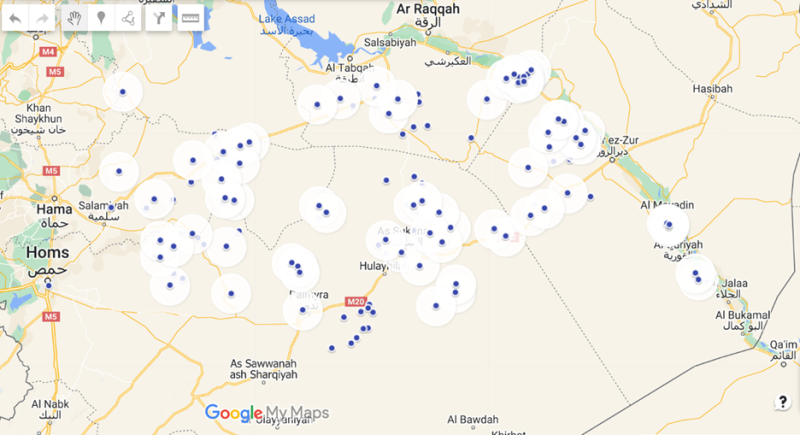
*High quality attacks are defined as attacks behind frontlines, those that result in seized positions, target regime officers, involve coordinated attacks on multiple positions, fake checkpoints, ambushes on military convoys, or attacks on checkpoints that kill at least three soldiers or lead to POWs.
 Eurasia Press & News
Eurasia Press & News
